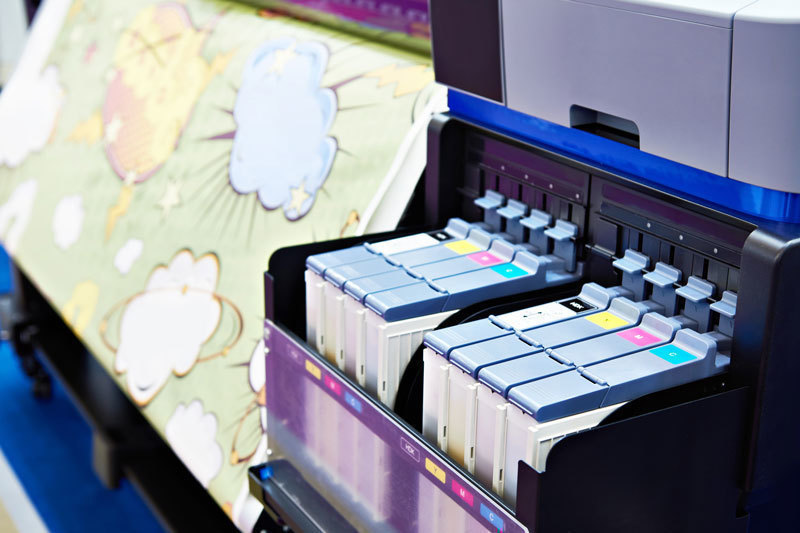
Advancements in Dye Sublimation Printing
Dye sublimation printing or dye sub is changing the way that companies throughout the visual merchandising and marketing fields complete their fabric printing work. The process supports cost efficiency in terms of shipping, handling, and installing signage or graphics and is helping companies craft imagery that resonates. In this latest post, we’ll explore the many benefits that dye sublimation is bringing to the marketplace and highlight how to choose a dye-sub printing professional for printing designs on fabric.
What is Dye Sublimation Printing and How Does It Work With Fabric Printing?
Dye-sub printing is the process of transferring your image onto a substrate using sublimation ink. The image is first printed onto sublimation transfer paper, and then the sublimation paper is used to transfer the ink onto the fabric. The process allows for the ink to become a part of the substrate it’s printed on, presenting a clear image and resulting in a multitude of other functional benefits.
How Does Dye Sub Fabric Printing Differ from Inkjet Fabric Printing?
When you print using inkjet printing, you’re only able to print on top of the fabric. While other printing methods go through three distinct states (solid, liquid, and gas), sublimation prints don’t pass the liquid state. The sublimation ink combines with the substrate while it’s in its gaseous state. The ink then solidifies and merges with the substrate and forms the image that has been designed.
What is Dye Sublimation Ink?
Dye sublimation inks are pigments that are suspended within a liquid solvent, which means they’re more similar to water than traditional ink products. The control granted to teams using sublimation inks means they can achieve far superior fabric printing results to other ink products.
Dye Sub Lasts Longer Than Other Products
One clear benefit of dye sublimation is that the chemical bonding of the ink with the softer material ensures the finished product is highly durable. The product lasts just as long and potentially longer than traditional graphic materials, and they can be easily and effectively maintained. For example, your team can wash or steam your dye-sub material without worrying about damage to the aesthetics.
The Final Product Looks Better
Your customers will be able to notice the clear difference when working with dye sublimation and comparing the finished product with inkjet printing. Because the entire process utilizes a continuous flow of colour, rather than individual dots, the finished product is pristine. The colours are far clearer and brighter, and the depth of colour is incomparable to any other style of printing.
More Cost-Effective
Working with dye sublimation can help companies reduce the cost of their printed products considerably. Dye-sub printed fabric is lighter than the traditional rigid materials utilized for display products, so shipping costs are reduced by hundreds of dollars per package. Further shipping savings can be made by folding or rolling the fabric flat so that the display product takes up less room within the container. It’s an advantage many companies are now taking into their future campaigns and using the extra resources to improve their marketing strategies.
Sublimation Printing is Environmentally Friendly
Companies across the globe are now trying to find new methods for fabric printing that are environmentally friendly and help ensure a sustainable future. Each element of the sublimation process has been honed to ensure that it supports the company’s environmental objectives. For example, because the printing method doesn’t use water in its heat-transfer process, it helps limit the overuse of resources. Another advantage is that the dyes used in dye-sublimation printing are environmentally safe. They don’t pose any risks to the local region or to those who are handling and using the inks on a regular basis.
The sublimated prints can also be used multiple times to create graphics, further helping limit the waste of resources and reduce expenditures.
Variety of Digital Options
Another of the benefits presented by dye-sub printing is that you can achieve a high variation of textiles for digital printing work. For example, dye-sub processes are effective with woven, vinyl, polyester, and rigid materials. The final product remains exceptionally strong and resilient. Companies can also use aluminum frames during the installation process for a more polished appeal when setting up the graphics.
Greater Format Options
Large format graphics are now being harnessed throughout the marketing and graphic design marketplace, and so companies must utilize processes that capitalize on the effectiveness of large formats. Using dye-sub printing techniques, you can easily and effectively print on 16-foot-wide banners of various lengths. The colour clarity and tone make dye-sub the superior choice for this style of large format printing.
Simpler Storage
A significant challenge for many companies promoting their businesses at events around the country is storing their marketing materials effectively for the years to come. Dye-sub printing is an excellent option for simplifying the storage process. Compared to the more rigid substrates some companies now use within their marketing campaigns, fabric prints are lightweight and flexible and can be folded for easier storage. Companies can consolidate their campaign costs considerably when using their fabrics with dye-sub prints for future campaigns.
Important Elements to Remember for Dye-Sublimation Fabric Printing
So now that you have a clear idea about the value that dye sublimation printing can bring to your clients’ campaigns, let’s look at a couple of elements you should remember in order to get the most value for your investment when printing on fabric.
Ensure the Highest Quality Wide Format Fabrics
When choosing materials for your dye-sublimation printing, ensure you speak with wide format fabric companies about the best materials for the working process. The suitability of the material will be critical to getting the best value from the printing process.
Carefully Review Graphics
Your clients should also review the format of graphics when working with dye-sub printing processes. The printing and design work should be completed by a professional with years of experience in large formatting printing.
